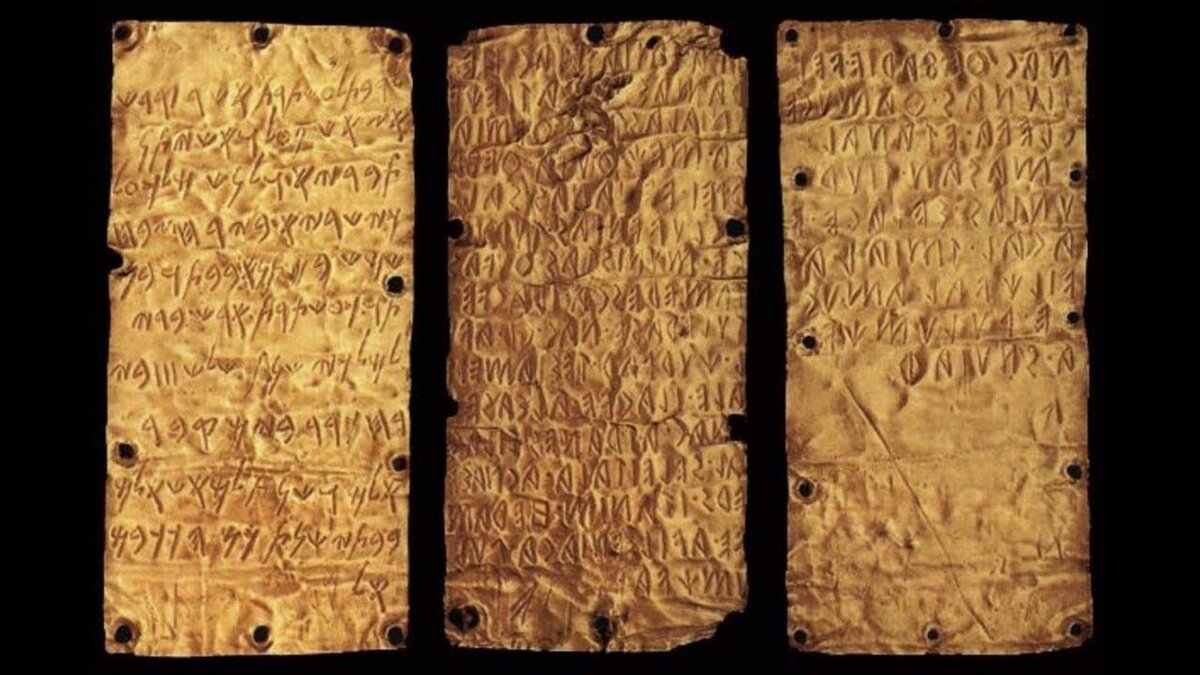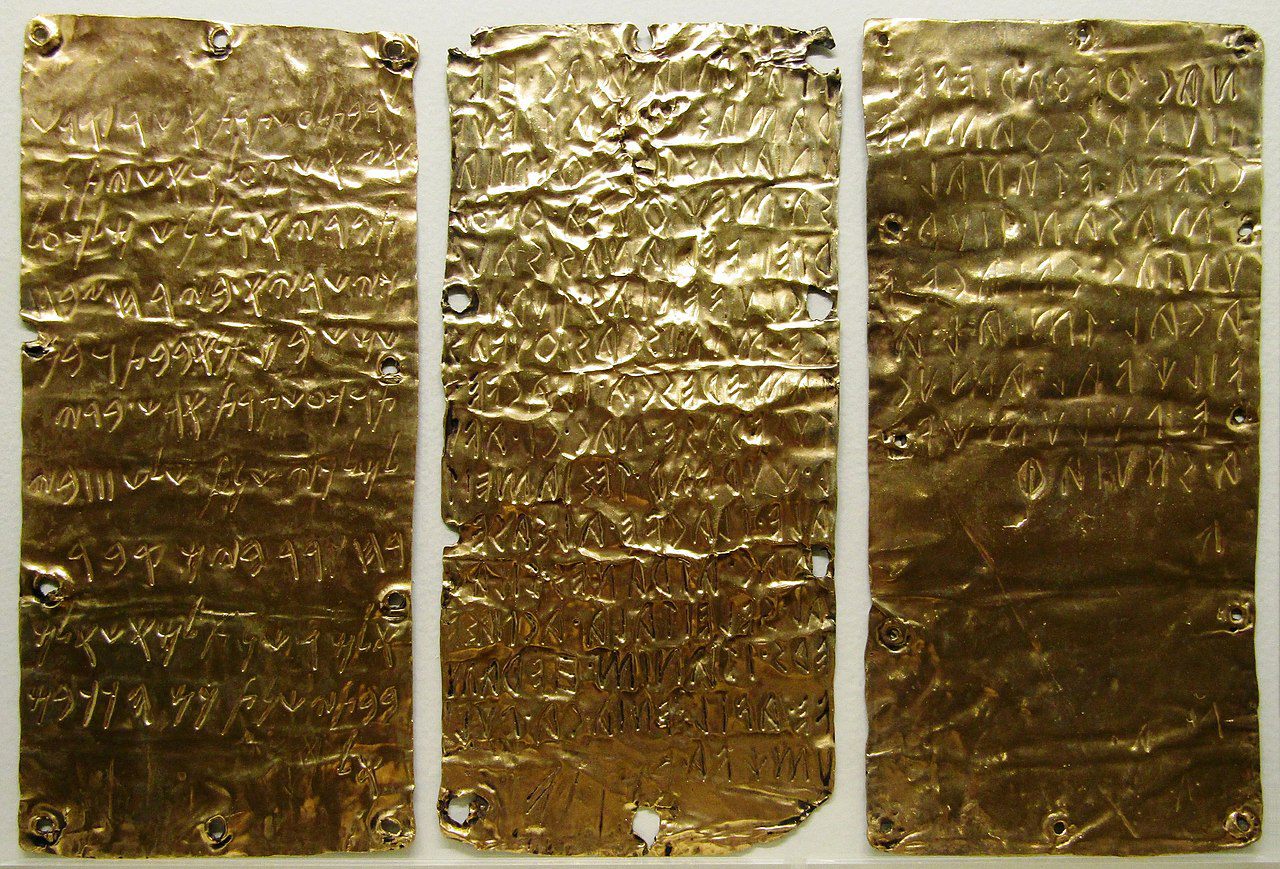Hidden away in the ancient ruins of Pyrgi, a small coastal town in Italy, lies a treasure that has puzzled archaeologists and historians for centuries – the Pyrgi Gold Tablets. These enigmatic artifacts, made of pure gold and covered in inscriptions written in both Phoenician and Etruscan, are some of the most significant discoveries in the history of ancient Mediterranean civilizations.

Despite their small size, the Pyrgi tablets reveal a fascinating glimpse into the complex relationships and cultural exchange between the Phoenicians and Etruscans, two of the most influential civilizations of the ancient world. From their mysterious origins to their significance in understanding the linguistic and cultural connections between these two great empires, the Pyrgi Gold Tablets continue to captivate and intrigue scholars and enthusiasts alike. Join us as we delve into the fascinating story of the Pyrgi tablets and unlock the secrets of this incredible treasure.
The Pyrgi Gold Tablets

The Pyrgi Gold Tablets are a set of three inscriptions made of gold leaf and discovered in 1964 in the ancient city of Pyrgi, located in present-day Italy. The inscriptions are written in the Phoenician and Etruscan languages and are believed to date back to the 5th century BCE. The tablets are considered to be one of the most significant archaeological discoveries of the 20th century, as they provide valuable insights into the cultures and societies of the Phoenician and Etruscan civilizations.
The Phoenician civilization
The Phoenician civilization was a maritime trading culture that emerged around 1500 BCE in the eastern Mediterranean region. The Phoenicians were known for their seafaring and trading skills and established colonies across the Mediterranean, including in present-day Lebanon, Syria, and Tunisia. The Phoenician language was a Semitic language similar to Hebrew and Arabic.
The Phoenicians were also skilled craftsmen and were renowned for their metalworking and glassmaking techniques. They also developed an alphabet that was widely used in the Mediterranean world and influenced the development of the Greek and Latin alphabets. To say, it took a vital role in the evolution of today’s world languages and human understanding.
The Etruscan civilization
The Etruscan civilization emerged in Italy around the 8th century BCE and was centered in the region of Tuscany. The Etruscans were known for their artistic and architectural achievements and for their sophisticated system of government. They also had a highly developed system of writing, Etruscan Language, which was written from right to left and said to be influenced by the Greek alphabet.
According to some scholars, Etruscan is not an isolate language. It is closely related to two other languages: a) Raetic, a language once spoken at about the same time as Etruscan in what is today northern Italy and Austria, and b) Lemnian, once spoken on the Greek island of Lemnos, off the coast of Turkey, which is possibly an indicator of the origins of the ancestor language of all three languages being in Anatolia, and its spread possibly occurring as a result of emigration in the chaos following the collapse of the Hittite Empire.
On the contrary, many researchers claim that the Etruscan language is a unique, non-Indo-European outlier in the ancient Greco-Roman world. There are no known parent languages to Etruscan, nor are there any modern descendants, as Latin gradually replaced it, along with other Italic languages, as the Romans gradually took control of the Italian peninsula.
Like the Phoenicians, the Etruscans were also skilled metalworkers and produced objects of great beauty, such as jewelry, bronze statues, and pottery. They were also skilled farmers and developed sophisticated irrigation systems that allowed them to cultivate crops in the arid Italian landscape.
The discovery of the Pyrgi Gold Tablets
The Pyrgi Gold Tablets were discovered in 1964 by a team of archaeologists led by Massimo Pallottino in the ancient city of Pyrgi, located in present-day Italy. The inscriptions were found in a temple dedicated to the goddess Uni, who was worshipped by both the Phoenicians and Etruscans.
The tablets were made of gold leaf and were found in a wooden box that had been buried in the temple. The box was discovered in a layer of ash that was believed to have been caused by a fire that destroyed the temple in the 4th century BCE.
Deciphering the Pyrgi Gold Tablets
The Pyrgi Gold Tablets were written in both the Phoenician and Etruscan languages, which posed a challenge for scholars trying to decipher the inscriptions. The task was made more difficult by the fact that the inscriptions were written in a form of Etruscan that was not well understood and had not been seen before.

Despite these challenges, scholars were eventually able to decipher the inscriptions with the help of comparative linguistic analysis and the discovery of other Etruscan inscriptions. The tablets contain a dedication by King Thefarie Velianas to the Phoenician goddess Astarte, also known as Ishtar.
Ishtar was originally worshipped in Sumer as Inanna. The cult of the ancient Mesopotamian goddess associated with love, beauty, sex, desire, fertility, war, justice, and political power spread throughout the region. In time, she was also worshipped by the Akkadians, Babylonians, and Assyrians.
The Pyrgi gold tablets are rare and unusual. They are an ancient treasure both from a linguistic and a historical point of view. The tablets offer researchers the possibility to use the Phoenician version to read and interpret the otherwise undecipherable Etruscan.
Deciphering the Phonecian one
According to William J. Hamblin, a professor of history at Brigham Young University, the three Pyrgi Gold Tablets are a prime example of the spread of the Phoenician practice of writing sacred texts on golden plates from their original center in Phoenicia, via Carthage, to Italy, and is roughly contemporary with the Book of Mormon’s claim that sacred texts were written on metal plates by the Phoenicians’ closer neighbors, the Jews.
There was really no need to decipher these fascinating ancient tablets because the Phoenician text has long been known to be Semitic. Though the artifacts may not be regarded as an ancient enigma, they are nevertheless of extraordinary historical value and give us a unique insight into how ancient people communicated their beliefs and showed worship of their beloved goddess Astarte (Ishtar, Inanna).
The Phonecian inscription reads:
To lady Ashtarot,
This is the holy place, which was made, and which was given by Tiberius Velianas who reigns over the Caerites.
During the month of the sacrifice to the Sun, as a gift in the temple, he built an aedicula (an ancient shrine).
For Ashtarot raised him with Her hand to reign for three years from the month of Churvar, from the day of the burial of the divinity [onward].
And the years of the statue of the divinity in the temple [shall be] as many years as the stars above.
The significance of the Pyrgi Gold Tablets in understanding the Phoenician and Etruscan civilization
The Pyrgi Gold Tablets are significant because they provide valuable insights into the cultures and societies of the Phoenician and Etruscan civilizations. The inscriptions reveal the close relationship between the two civilizations and shed light on their religious practices and beliefs.
The inscriptions also provide evidence of the Phoenician presence in Italy and their influence on the Etruscan civilization. The tablets reveal that the Phoenicians were involved in the trading of precious metals, such as gold, and that they played an important role in the religious practices of the Etruscans.
Similarities and differences between the Phoenician and Etruscan civilization
The Phoenician and Etruscan civilizations had many similarities, including their skills in metalworking and their sophisticated systems of government. Both cultures were also known for their seafaring and trading skills, and they established colonies across the Mediterranean.
Despite these similarities, there were also significant differences between the two civilizations. The Phoenicians were a maritime culture that focused on trade and commerce, while the Etruscans were an agricultural society that focused on farming and the cultivation of the land.
Current status of the Pyrgi Gold Tablets
The Pyrgi Gold Tablets are currently housed in the National Etruscan Museum, Villa Giulia, in Rome, where they are on display for the public to view. The tablets have been studied extensively by scholars and continue to be an important topic of research for archaeologists and historians.
Conclusion: Importance of the Pyrgi Gold Tablets in world history
The Pyrgi Gold Tablets are a fascinating insight into the cultures and societies of the Phoenician and Etruscan civilizations. The inscriptions provide valuable insights into the religious practices and beliefs of these two civilizations and reveal the close relationship between them.
The discovery of the Pyrgi Gold Tablets has contributed significantly to our understanding of world history and has shed light on the complex relationships between different cultures and societies. The tablets are a testament to the importance of archaeology and the role it plays in uncovering the mysteries of the past.




